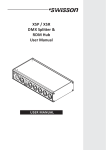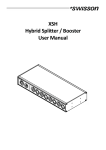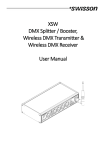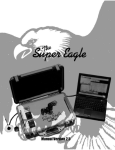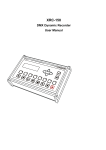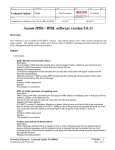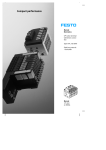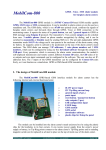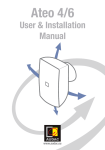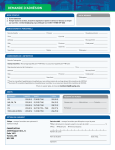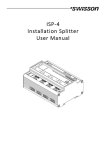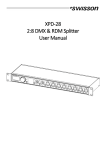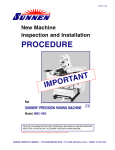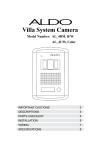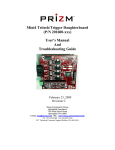Download XSP & XSR Splitter Series User Manual - SIRS-E
Transcript
XSP / XSR DMX Splitter & RDM Hub User Manual XSP / XSR DMX Splitter /RDM Hub User Manual Issue 4 (2010-06-15) Copyright © 2010 SWISSON AG No part of this documentation may be reproduced or transmitted in any form or by any means, electronic or mechanical, including photocopying and recording, without the prior written permission of SWISSON AG. The information in this documentation is supplied without warranty of any kind, either directly or indirectly, and is subject to change without prior written notice. SWISSON its employees or appointed representatives will not be held responsible for any damages to software, hardware, or data, arising as a direct or indirect result of the product(s) mentioned herein. Dieses Dokument darf weder vollständig noch auszugsweise in irgendwelcher Form reproduziert, kopiert oder gespeichert werden, ohne das vorherige schriftliche Einverständnis der Firma SWISSON AG. Die Informationen in diesem Dokument sind ohne jegliche Gewähr und können ohne vorherige Ankündigung jederzeit im Sinne des technischen Fortschritts geändert werden. SWISSON und seine Angestellten oder seine Vertreter sind nicht verantwortlich für Schäden, welche direkt oder indirekt mit den in diesem Dokument beschriebenen Geräten entstanden sind. Issued by SWISSON AG Fabrikstrasse 21 CH-3250 Lyss Switzerland E-Mail: [email protected] SWISSON of AMERICA Corp. 2419 East Harbor Blvd. #34 Ventura, CA 93001 U.S.A. XSR and XSP DMX Splitter/Booster & RDM Hub Introduction The XSR and XSP series of RDM hubs and DMX splitter/boosters, from SWISSON can be easily and economically integrated into any lighting system where you wish to spilt and boost DMX and RDM signals. While the XSP spiltts and boost only DMX signals, the XSR also detect RDM Data and use its bidirectional functionality to report back to the Controller (Lighting Board). All output ports on both XSP and XSR are optically isolated. A strong power supply allows a reliable operation in a wide voltage range. A large program of XSR and XSP devices is available; consisting of different housings, different connector types and different numbers of input and output ports. Applications ! ! ! ! Concert Lighting Live Events Multimedia Shows Theater ! TV Sets ! Theme Parks ! Achitectural Lighting Typical Application DMX Light Board with or without RDM functionality DMX Fixtures with or without RDM functionality DMX Dimmers with or without RDM functionality The XSR works within DMX / RDM environments and works as well as in pure DMX environments. The XSR is a good solution for those who expect to use RDM in future because the XSR acts as a normal DMX splitter if there is no RDM Data. The XSP work only within DMX evironments. 2 Benefits using a XSP/XSR Splitter / Booster Boost On installations with excessively long cable runs the DMX and/or RDM signal can be compromised or significantly weakened by the distance. Good signal Weak signal bad signal The XSP/XSR boosts the signals thus eliminating signal interference Good signal Weak signal Good signal Regenerate In harsh environments DMX and RDM signals can be disturbed or corrupted. Good signal Disturbed signal disturbance bad signal disturbance The XSP/XSR cleans and regenerates the signals. Good signal Disturbed signal Good signal disturbance 3 Split A simple split of signal lines is not allowed. The bidirectional operation of RDM is even more sensitive to the split on that than DMX. not allowed A split of the signal lines is possible with the XSR / XSP by using different output ports Reduces reflection problems Signal reflection is a common problem on large DMX installations or on long signal lines. The bidirectional operation of RDM is more sensitive to reflections than DMX. Weak reflection with large delay. Signal OK Strong reflection with large delay. Bad signal ! Strong reflection with small delay. Signal OK The XSP/XSR split the line into smaller segments with a regenerated signal, which reduces the delay of the reflection on each segment. Reflection with small delay. Signal OK Reflection with small delay. Signal OK 4 Protect In case of an over voltage on the DMX and RDM line(s), all devices on that line can be damaged. The XSP/XSR separate the line into multiple segments. The over voltage is restricted to the concerned segment. The XSP/XSR itself is well protected against transient over voltage and the optical isolation of each port prevents a damage of other ports and segments in case of a permanent over voltage. XSP Block Diagram Control Logic Optical Isolation Optical Isolation Optical Isolation Optical Isolation Optical Isolation Line Termination Transmitter Transmitter Transmitter Transmitter Transmitter Protection Protection Protection Protection Protection Protection Out Port 1 Out Port 2 Out Port 3 Out Port 4 Out Port 5 In Port Thru Port Termination Receiver 5 XSR Block Diagram Control Logic Optical Isolation Optical Isolation Optical Isolation Optical Isolation Optical Isolation Line Termination Tranceiver Tranceiver Tranceiver Tranceiver Tranceiver Protection Protection Protection Protection Protection Protection Out Port 1 Out Port 2 Out Port 3 Out Port 4 Out Port 5 In Port Thru Port Termination DMX Only Teanceiver Mains Connection Two different Mains connections are available: The US versions are delivered by Swisson with a "Edison Plug" (NEMA-5-15). These models has a "-US" suffix at the end The International versions are delivered without any plug. Swisson distributors or dealers may deliver the devices with a country specific plug. Yellow/Green : Earth Brown : Phase US Versions (-US suffix) Blue : Neutral International Versions Input Section XSP Versions The Input section of the versions with XLR connectors 6 The Input section of the versions with terminals: The “input” and “thru” terminals are at the rear of the device. The Power LED shows if the device powered and if power supply unit of the XSP is working A green LED shows if a signal is available at the Input port. A red LED shows if the received signal is faulty The XSP has a built in line termination. This can be activatet by pressing the termination button. A LED shows if the termination is activated. Input Section XSR Versions The Input section of the XSR versions with XLR connectors The Input section of the XSR versions with terminals: The “input” and “thru” terminals are at the rear of the device. The Power LED shows if the device powered and if the power supply unit of the XSR is working A multicolor LED shows if a signal is available at the Input port. The LED has 3 different states: Off: No signal present Green: Signal is present and Ok Red: Signal is present but faulty 7 The RDM LED show if RDM data packets are preset. In a pure DMX environment this LED remains off. The XSR has a built in line termination. This can be activatet by pressing the termination button. A LED shows if the termination is activated. The "dmx only" function of the XSR allows removal off all RDM data from the outupt ports. A LED shows if the "dmx only" function is activated. Input and Thru Port The THRU port is hardwired with the INPUT port and allows to daisy-chain the devices even when the XSR is not powered. On all XSP and XSR models with 5Pin XLR connector the pin 4 and 5 are also looped thru to the THRU port. On all other models pin 4 & 5 are not available. Protection Line Termination Input Port Teanceiver Thru Port 1 2 3 4 5 1 2 3 4 5 Line Termination All XSP and XSR splitters have a built-in line termination. The termination is activated by pressing the termination button. On terminal and Installation version the button is only accessible with a tool (such as a paper clip). 8 DMX Only (only on XSR models) The "DMX only" function removes all non DMX data before forwarding the data to the output ports. RDM data will be removed too. This can be helpfull when DMX devices are not compatible and do not check the data they receive as valid DMX. The "DMX only" function is activated by pressing the "DMX only" button. On terminal and Installation version the button is only accessible with a tool. Output Ports The output section of the versions with XLR connectors: The OUTPUT section of the versions with terminals: The OUTPUT terminals are at the rear of the devices. Each output port is individually optically isolated, meaning that it is totally isolated from the other output ports and the input selection. The Pins 4&5 on the models with 5-Pin XLR connectors are not connected. Controller Supply Port Supply Output Port Control Logic Optical Isolation Tranceiver Bias Network Protection n.c. 1 2 3 4 5 On the XSR the signal LED of the OUTPUT ports show if a valid signal is transmitted. It works bidirectionally: When sending DMX or RDM packets and when receiveing RDM responces. This LED is not available on the XSP models. 9 XSP / XSR Box Models 45mm 217.5mm 112mm Mains cable Mains plug (US-Versions only) cable length approx. 145cm M10 female threat for clamp Eye for savety wire The length of the M10 screw which enters the XSP/XSR should not exceed a maximum of 20mm. 20mm MAX Clamp is not included with the XSP/XSR. 10 Single Rack Models 482mm 45mm 112mm cable length approx. 145cm Mains plug (US-Versions only) Double Rack Models 482mm 45mm 112mm cable length approx. 145cm Mains plug (US-Versions only) 11 Single Rack Terminal Models 482mm 45mm 112mm Double Rack Terminal Models 482mm 45mm 112mm 12 Terminal Models The terminal models of the XSP/XSR comes with plugable treminal blocks. The terminal blocks are located at the rear of the device. XSP/XSR terminal models are shipped with the terminal blocks. They can accept wires up to AWG 17 (~1mm2) Installation model The XSP/XSR installation modell is made to be installed by certified professionals. This version has no plugs. All connections are located inside of the device. input port mains thru port output ports cover grommets 13 XSP standard program 10 11 63 11 11 63 XSP-3B XSP-3B-US (with NEMA 5-15) Front view Rear view 10 11 74 11 11 74 XSP-3R XSP-3R-US (with NEMA 5-15) Front view Rear view 10 11 85 11 11 85 XSP-3R-3R XSP-3R-3R-US (with NEMA 5-15) Front view Rear view 10 11 62 11 11 62 XSP-5B XSP-5B-US (with NEMA 5-15) Front view Rear view 10 11 72 11 11 72 XSP-5R XSP-5R-US (with NEMA 5-15) Front view Rear view 10 11 82 11 11 82 XSP-5R-5R XSP-5R-5R-US (with NEMA 5-15) Front view Rear view 14 10 11 60 11 11 60 XSP-5B5 XSP-5B5-US (with NEMA 5-15) Front view Rear view 10 11 70 11 11 70 XSP-5R5 XSP-5R5-US (with NEMA 5-15) Front view Rear view 10 11 80 11 11 80 XSP-5R5-5R5 XSP-5R5-5R5-US (with NEMA 5-15) Front view Rear view 10 11 87 11 11 87 XSP-5R2-5R2 XSP-5R2-5R2-US (with NEMA 5-15) Front view Rear view 10 11 84 11 11 84 XSP-5R-5R5 XSP-5R-5R5-US (with NEMA 5-15) Front view Rear view 10 11 86 11 11 86 XSP-5R-3R XSP-5R-3R-US (with NEMA 5-15) Front view Rear view 15 10 11 50 11 11 50 XSP-TR5 XSP-TR5-US (with NEMA 5-15) Front view OUT 5 OUT 4 OUT 3 OUT 2 OUT 1 THRU IN Rear view 10 11 51 11 11 51 XSP-TR5-TR5 XSP-TR5-TR5-US (with NEMA 5-15) Front view OUT 5 OUT 4 OUT 3 OUT 2 OUT 1 THRU IN OUT 5 OUT 4 OUT 3 OUT 2 OUT 1 THRU IN Rear view 10 11 98 XSP-IB5-W Front view Rear view XSR standard program 10 12 10 11 12 10 XSR-3B XSR-3B-US (with NEMA 5-15) Front view Rear view 10 12 20 11 12 20 XSR-3R XSR-3R-US (with NEMA 5-15) Front view Rear view 10 12 30 11 12 30 XSR-3R-3R XSR-3R-3R-US (with NEMA 5-15) Front view Rear view 16 10 12 11 11 12 11 XSR-5B XSR-5B-US (with NEMA 5-15) Front view Rear view 10 12 21 11 12 21 XSR-5R XSR-5R-US (with NEMA 5-15) Front view Rear view 10 12 31 11 12 31 XSR-5R-5R XSR-5R-5R-US (with NEMA 5-15) Front view Rear view 10 12 16 11 12 16 XSR-5B5 XSR-5B5-US (with NEMA 5-15) Front view Rear view 10 12 26 11 12 26 XSR-5R5 XSR-5R5-US (with NEMA 5-15) Front view Rear view 10 12 33 11 12 33 XSR-5R5-5R5 XSR-5R5-5R5-US (with NEMA 5-15) Front view Rear view 17 10 12 35 11 12 35 XSR-5R2-5R2 XSR-5R2-5R2-US (with NEMA 5-15) Front view Rear view 10 12 34 11 12 34 XSR-5R-5R5 XSR-5R-5R5-US (with NEMA 5-15) Front view Rear view 10 12 32 11 12 32 XSR-5R-3R XSR-5R-3R-US (with NEMA 5-15) Front view Rear view 10 12 50 11 12 50 XSR-TR5 XSR-TR5-US (with NEMA 5-15) Front view OUT 5 OUT 4 OUT 3 OUT 2 OUT 1 THRU IN Rear view 10 12 51 11 12 51 XSR-TR5-TR5 XSR-TR5-TR5-US (with NEMA 5-15) Front view OUT 5 OUT 4 OUT 3 OUT 2 OUT 1 THRU IN OUT 5 OUT 4 Rear view 10 12 51 XSR-IB5-W Front view Rear view 18 OUT 3 OUT 2 OUT 1 THRU IN Technical Data Mains Voltage 110 / 230 [VAC] Main Frequency 50/60 [Hz] Current Consuption Single Units 0.25 [A] Current Consuption Double Units 0.5 [A] Operating Temperature 0F to 130F (-17!C to 55!C) Protocol Standard ANSI E1.11 (DMX-512) ANSI E1.20 (RDM) Safety Standards EN60950-1 UL????? EMC emmision EN50081-1 EN50081-2 EMC immunity EN50081-1 EN50081-2 Safety notes Consider the following notes absolutely when you set up, connect and use the XSP / XSR ! Connect the cables only with the proper plugs and sockets. ! Set the cables in an accident-proof fashion. Connected cables mustn't be stressed mechanically too much. ! Keep the device away from sources of electrical interference.. ! Only connect accessories certified for use with this device. ! Never open the device yourself. Don't touch the plug contacts with metal or sharp/pointed objects. ! Clean the XSP/XSR DMX Splitter only with a soft, damp cloth. Don't use chemicals or scrubbing means. ! Protect the device against against exposure to: excessive humidity, liquids, moisture, dust, direct sunlight. ! Do not use the device in areas where it is exposed to direct sunlight. ! Do not use the device in areas that are considered to be 'highly combustible'. 19 20




















